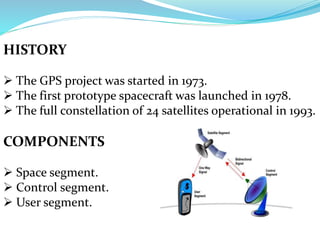GIS and GPS
- 2. What is GIS? It refers to Geographic Information System. GIS is a computer system capable of assembling storing, manipulating, and displaying geographically referenced information.
- 3. HISTORY Coined by Rogar Tomilson in 1963. Tomilson acknowledged as the "father of GIS”. COMPONENTS There are 3 components in GIS. 1. Data 2. User 3. Computer system
- 4. TYPES There are 3 types of GIS. 1. Web based GIS 2. Geo browser GIS 3. Desktop GIS PRINCIPLE 1. Data capture 2. Database management and update 3.Geography analyis 4. Preparing result
- 5. ADVANTAGES 1. GIS allows to view , understands and visulized data in many ways. 2. GIS gives the accurate data. 3. Better prediction and analysis. DISADVANTAGES 1. Expensive software 2. Excessive damage in case of internal fault
- 6. WHAT IS GPS ? It refers to the Global Positioning System. It is the system to show you and your exact location on the earth anytime, in any whether.
- 7. HISTORY The GPS project was started in 1973. The first prototype spacecraft was launched in 1978. The full constellation of 24 satellites operational in 1993. COMPONENTS Space segment. Control segment. User segment.
- 8. HOW IT WORKS Device is installed inside the vehicle Device is located by satellite via GPS GPS value is sent to server via GPRS Server stores the data for 365 days log-on to the website to monitor
- 9. APPLICATIONS Location Navigation Tracking Mapping Timing
- 10. ADVANTAGES 1. Fast speed. 2. Leads you in all direction. 3. Accuracy level is very possible. DISADVANTAGES 1. Driving distraction. 2. Signal or battery failure 3. Privacy issues and crime.
- 11. FUTURE OF GPS The most certain aspect of the future of GPS is its increased usage and its expansion into new areas of application. • Automobiles • Ships • Farm vehicles • Aircrafts • Military systems











